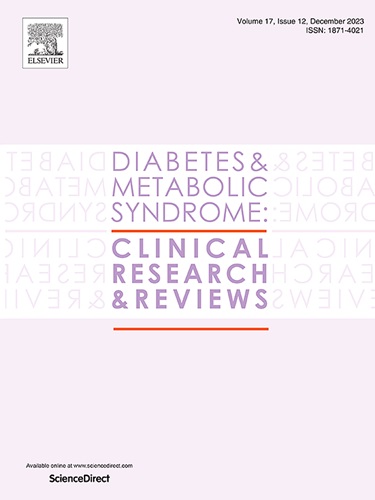修订了生活在印度的亚洲印度人的肥胖定义。
IF 3.4
Q1 ENDOCRINOLOGY & METABOLISM
Diabetes & Metabolic Syndrome-Clinical Research & Reviews
Pub Date : 2025-01-01
DOI:10.1016/j.dsx.2024.102989
引用次数: 0
摘要
目的:2009年出版的针对亚洲印度人肥胖的流行指南,仅仅依赖于身体质量指数(BMI)标准。认识到BMI在准确诊断肥胖方面的局限性,以及新研究的出现揭示了亚洲印第安人的全身性和腹部肥胖与早发合并症之间的联系,需要全面重新定义。方法:采用针对印度肥胖问题的德尔菲法,通过电子邮件邀请专家参与五轮调查。调查问题通过谷歌Form进行管理,以收集选定专家的见解。结果:在1期肥胖中,个体表现出肥胖增加(BMI>23 kg/m2),但对器官功能或日常活动没有明显影响。第2阶段肥胖是一种更高级的状态,其特征是肥胖(全身和腹部)加剧,影响身体和器官功能,导致日常活动中的功能限制,并导致合并症。第二阶段肥胖的标准包括强制性BMI超过23 kg/m2,并且至少有以下一项:腰围过大或腰高比。此外,需要出现一种或多种表明日常活动受限的症状,或一种或多种肥胖相关的合并症/疾病,以支持2期肥胖。结论:该改进框架旨在提高在印度生活的亚洲印度人肥胖及其相关健康风险识别的准确性,促进合理管理,并与全球肥胖症新定义的倡议保持一致。本文章由计算机程序翻译,如有差异,请以英文原文为准。
Revised definition of obesity in Asian Indians living in India
Aim
The prevailing guidelines for obesity in Asian Indians, published in 2009, relied solely on body mass index (BMI) criteria. Recognizing the limitations of BMI in accurately diagnosing obesity and the emergence of new research revealing the association between generalized and abdominal adiposity in Asian Indians and early-onset co-morbid diseases, a comprehensive redefinition was needed.
Method
In a Delphi process focused on obesity in India, experts were invited via email to participate in five rounds. The survey questions were administered through Google Form to gather insights from the selected experts.
Results
In Stage 1 Obesity, individuals exhibit increased adiposity (BMI>23 kg/m2) without discernible effects on organ functions or daily activities. Stage 2 Obesity denotes a more advanced state characterized by heightened adiposity (generalized and abdominal), impacting both physical and organ functions, resulting in functional limitations during day-to-day activities, and contributing to co-morbid diseases. The criteria for Stage 2 Obesity include a mandatory BMI exceeding 23 kg/m2 and at least one of the following: excess waist circumference or waist-to-height ratio. Additionally, the presence of one or more symptoms indicative of limitations in daily activities or one or more obesity-related comorbid conditions/diseases are needed to support the stage 2 obesity.
Conclusion
This refined framework seeks to enhance precision in identifying obesity and its associated health risks among Asian Indians living in India, and facilitation of rational management, and aligns with worldwide initiative of new definition of obesity.
求助全文
通过发布文献求助,成功后即可免费获取论文全文。
去求助
来源期刊

Diabetes & Metabolic Syndrome-Clinical Research & Reviews
ENDOCRINOLOGY & METABOLISM-
CiteScore
22.90
自引率
2.00%
发文量
248
审稿时长
51 days
期刊介绍:
Diabetes and Metabolic Syndrome: Clinical Research and Reviews is the official journal of DiabetesIndia. It aims to provide a global platform for healthcare professionals, diabetes educators, and other stakeholders to submit their research on diabetes care.
Types of Publications:
Diabetes and Metabolic Syndrome: Clinical Research and Reviews publishes peer-reviewed original articles, reviews, short communications, case reports, letters to the Editor, and expert comments. Reviews and mini-reviews are particularly welcomed for areas within endocrinology undergoing rapid changes.
 求助内容:
求助内容: 应助结果提醒方式:
应助结果提醒方式:


